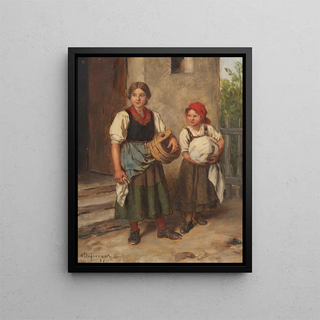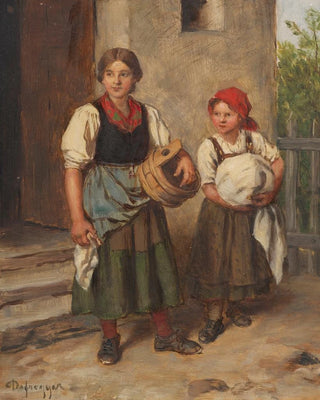Farmhouse Painting with Dirndl in front of the laundry - Franz von Defregger | Art print


View from behind

Frame (optional)
In the world of art, some works manage to capture the essence of an era while evoking timeless emotions. "Farmer with dirndl in front of the washhouse - Franz von Defregger" is one of those creations that transports us to the heart of 19th-century Austrian rural life. This painting, rich in detail and color, invites us to contemplate the simplicity and beauty of everyday life, while revealing the subtleties of alpine culture. The scene depicts a woman in a dirndl, dressed in her traditional attire, standing in front of a washhouse, a symbol of community life and domestic chores. This artwork reminds us of the importance of cultural roots and traditions, while offering a window into a bygone world.
Style and uniqueness of the work
The uniqueness of this piece lies in how Franz von Defregger succeeds in blending realism and romanticism. The chosen colors, both soft and vibrant, evoke a warm and welcoming atmosphere. Every detail, from the drape of the dirndl to the reflections of water in the washhouse, is carefully rendered, demonstrating undeniable technical mastery. The artist manages to breathe palpable life into his characters, who seem almost to come alive before our eyes. The composition, meanwhile, is harmonious, guiding the viewer’s gaze through the scene while creating a sense of depth. The choice of subject, rooted in daily life, transcends simple representation to offer a reflection on the human condition, work, and community.
The artist and his influence
Franz von Defregger, born in 1835, is one of the most prominent representatives of the 19th-century Austrian painting movement. His work is marked by a deep admiration for folk traditions and a desire to highlight the lives of simple people. Influenced by romanticism and realism, Defregger established himself as a visual storyteller, capable of capturing moments of life with rare sensitivity. His paintings, often imbued with a certain melancholy, reveal an intimate understanding of human nature and social dynamics. The artist was able to

Matte finish

View from behind

Frame (optional)
In the world of art, some works manage to capture the essence of an era while evoking timeless emotions. "Farmer with dirndl in front of the washhouse - Franz von Defregger" is one of those creations that transports us to the heart of 19th-century Austrian rural life. This painting, rich in detail and color, invites us to contemplate the simplicity and beauty of everyday life, while revealing the subtleties of alpine culture. The scene depicts a woman in a dirndl, dressed in her traditional attire, standing in front of a washhouse, a symbol of community life and domestic chores. This artwork reminds us of the importance of cultural roots and traditions, while offering a window into a bygone world.
Style and uniqueness of the work
The uniqueness of this piece lies in how Franz von Defregger succeeds in blending realism and romanticism. The chosen colors, both soft and vibrant, evoke a warm and welcoming atmosphere. Every detail, from the drape of the dirndl to the reflections of water in the washhouse, is carefully rendered, demonstrating undeniable technical mastery. The artist manages to breathe palpable life into his characters, who seem almost to come alive before our eyes. The composition, meanwhile, is harmonious, guiding the viewer’s gaze through the scene while creating a sense of depth. The choice of subject, rooted in daily life, transcends simple representation to offer a reflection on the human condition, work, and community.
The artist and his influence
Franz von Defregger, born in 1835, is one of the most prominent representatives of the 19th-century Austrian painting movement. His work is marked by a deep admiration for folk traditions and a desire to highlight the lives of simple people. Influenced by romanticism and realism, Defregger established himself as a visual storyteller, capable of capturing moments of life with rare sensitivity. His paintings, often imbued with a certain melancholy, reveal an intimate understanding of human nature and social dynamics. The artist was able to
12,34 €






